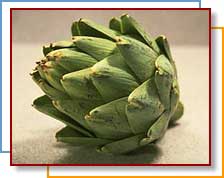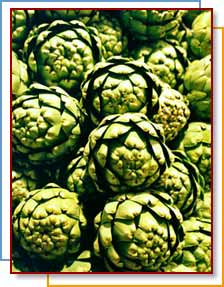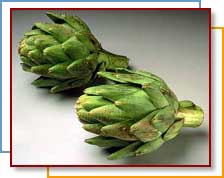
The artichoke was first developed in Sicily and was known to both the
Greeks and the Romans. In 77 AD the Roman naturalist Pliny called the
choke one of earth's monstrosities, but many continued to eat them.
Historical accounts show that wealthy Romans enjoyed artichokes prepared
in honey and vinegar, seasoned with cumin, so that this treat would be
available year round.
|
|
Artichokes |
Serving size 1
med. artichoke, cooked (120g)
| Amounts
Per Serving |
% Daily
Value |
| Calories
60 |
|
| Calories
from Fat 0 |
|
| Total Fat 0g |
0% |
| Saturated
Fat 0g |
0% |
| Cholesterol
0mg |
0% |
| Sodium 115mg |
5% |
| Total
Carbohydrate 13g |
4% |
|
Dietary Fiber 6g |
21% |
|
Sugars 1g |
|
| Protein 4g |
|
| Vitamin A |
4% |
| Vitamin C |
20% |
| Calcium |
6% |
| Iron |
8% |
* Percent Daily Values are based on a
2,000 calorie diet. |
|
| |
|
It was not until the early twentieth century that artichokes were grown
in the United States. All artichokes commercially grown in the United
States are grown in California and Castroville, California, claims to be
the "Artichoke Capital of the World." California even has an Artichoke
Queen — the most famous queen was Marilyn Monroe in 1947. She inspired
more people to eat artichokes in that year reign than any year before or
after.
Artichokes are actually a flower bud - if allowed to flower, blossoms
measure up to seven inches in diameter and are a violet-blue color.
Artichokes are a close relative to the thistle.
- Green Globe: year round and peaks in spring.
- Desert Globe: available from December through March and July
to September.
- Big Heart: year round, with a lull in April.
- Imperial Star: year round and peaks in spring.
Did you know?
The Jerusalem artichoke isn’t in the artichoke family, but is a
member of the sunflower family. Its ‘official’ name is actually
sunchoke. |
High-quality artichokes are usually compact and heavy for their size.
Squeezed, a fresh artichoke will make a squeak. The thickness of each
stalk should correspond to the size of the artichoke. Thin stalks signal
dehydration, so look for stalks that are firm without ‘give.’
Artichokes remain fairly constant in appearance for weeks, but flavor is
adversely affected from the moment they are cut from the stalk. For maximum
taste and tenderness, cook as soon as possible. Do not stock up on
artichokes. Refrigerate unwashed, in a plastic bag, for up to 1 week.
 Artichokes should be washed under cold running water. Pull off the lower
petals and cut the stems to one inch or less. Cut the top quarter of each
artichoke and snip off the sharp tips. Artichokes turn brown very quickly
once they are cut. To preserve the green color, one may dip in lemon water. Artichokes should be washed under cold running water. Pull off the lower
petals and cut the stems to one inch or less. Cut the top quarter of each
artichoke and snip off the sharp tips. Artichokes turn brown very quickly
once they are cut. To preserve the green color, one may dip in lemon water.
Artichokes can also stain the hands quite badly so it is recommended that
rubber gloves be worn for cleaning and chopping.
Artichokes can be boiled, steamed, microwaved or sautèed. They can be
eaten whole or added to other dishes.
Cooked artichokes may be refrigerated for several days in a covered
container.
Microwave: cook 6 to 8 minutes or until a petal near the center pulls out
easily.
Boiling: Stand artichokes in a large pan with 3 quarts boiling water.
Cover and boil gently 20 to 40 minutes according to size, or until the petal
near the center pulls out easily.
Small artichokes are good for pickling, stews, casseroles; medium size
are good for salads and large size are good for stuffing.
To eat, pull off leaves and eat the fleshy ends attached to the plant.
Lift out the cone and cut out the core, which is the fuzzy portion at the
center. The heart is a true delicacy and will break easily with a fork. Dip
the leaves in lemon juice or try the low-fat dipping sauce in the recipe
section.
 Recipes Recipes
Artichoke and Roasted Red Pepper Salad with Roasted Pepper Dressing
Makes 8 servings, each serving equals 1 cup of fruit or vegetables
Source: Produce for Better Health
Ingredients
8 Artichokes (medium size), prepared and cooked as directed for whole
artichokes
4 Red bell peppers
Lettuce leaves
½ cup Red onion, sliced
½ cup Ripe olives, sliced
1 Bell pepper (roasted), reserved from salad preparation (for Dressing)
1/3 cup Balsamic vinegar (for Dressing)
¼ cup White wine or cider vinegar (for Dressing)
2 cloves Garlic, minced (for Dressing)
1 Tsbp Basil (fresh), chopped or 1 tsp. crushed dried basil (for
Dressing)
1 tsp Rosemary (fresh), chopped or ½ tsp. crushed dried rosemary (for
Dressing)
Halve artichokes lengthwise; scoop out center petals and fuzzy centers.
Remove outer leaves and reserve to garnish salad, or to use for snacks
another time. Trim out hearts and slice thinly. Cover and set aside. Place
whole bell peppers under preheated broiler; broil under high heat until
charred on all sides, turning frequently with tongs. Remove from oven;
place in a paper bag for 15 minutes to steam skins. Trim off stems of
peppers; remove seeds and ribs. Strip off skins; slice peppers into
julienne strips. Reserve one-fourth of the bell pepper strips to prepare
dressing.
To assemble salads, arrange lettuce leaves on 8 salad plates. Arrange
sliced artichoke hearts, remaining bell pepper strips, red onion and olive
slices on lettuce. Garnish with a couple of cooked artichoke leaves, if
desired.
For dressing, in blender or food processor container place reserved
bell pepper strips, vinegars, garlic, basil, rosemary and sugar. Cover and
process until well blended and nearly smooth. Spoon dressing over salads.
Nutritional analysis per serving: Calories 133, Protein 8g, Fat 1g,
Calories From Fat 6%, Cholesterol 0mg, Carbohydrates 30g, Fiber 12g,
Sodium 378mg.

Find more in our
recipe database!
|



